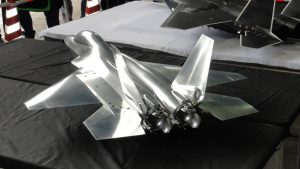More details have emerged regarding Japan’s next generation fighter concept. The Japanese Ministry of Defense published a new image of the projected fighter, alongside a plan to fund development of the aircraft to the total of some $260 billion. As Bradley Perrett makes clear, the Japanese want a big fighter with a long range and a lot of payload. Perrett offers the nickname “Godzilla” to describe the big fighter, which would likely enter service in the 2030s if Japan continues to pursue the program enthusiastically.
As far back as World War II, Japan has placed a high premium on aircraft range. The explicitly defensive writ of the JASDF during the Cold War put some limits on this, but it seems clear that in the future, Japan wants a long-range fighter aircraft capable of conducting operations at some distance from the home islands. Just showing up is a huge part of the battle, and the Japanese want to focus on characteristics that will allow the aircraft to reach contested areas, then remain on station in those areas for an extended period of time.
All that said, much of the future fighter project remains unsettled, including the logical targets for collaboration. Britain remains a strong possibility, as does the Future Combat Air System consortium and, of course, the United States even if the latter remains uncertain, given disagreement over requirements between the Navy and the Air Force, as well as the Air Force’s interest in restructuring the fighter design and production process. The nature of these collaborations will also shape the broader environment in which Generation 6 (or perhaps Generation 5.5, although we do not yet have a good way of distinguishing between the two) fighters will inhabit the international arms market. Collaborations, especially with the United States, add veto points to technology exports and reduce the export prospects of a fighter; that the F-35 has succeeded in spite of this is testimony to the magnitude of the program. But the question of whether Japan will sell “Godzilla” and if so to whom is almost as important as the nature of its service with the Japanese Air Self Defense Force.
The nature of the market for Generation 6 fighters remains murky, but in 20 years Godzilla may compete for contracts with the Tempest, the FCAS, the MiG-41, and whatever project or projects the United States eventually settles on. Japan has needs which a large, long-ranged fighter can uniquely fill, but Japan is not the only country with such needs, and it’s possible to imagine a situation in which other nations take an interest in acquiring Godzillla, or a variant thereof.

































